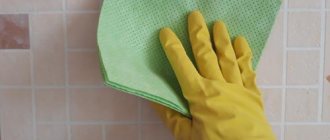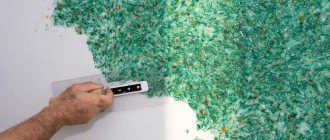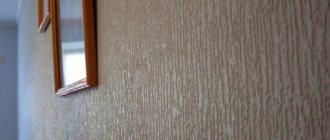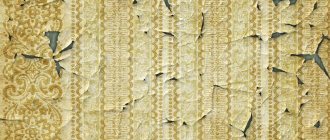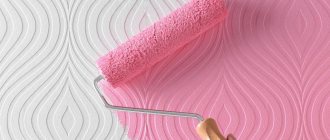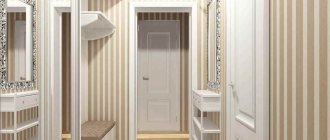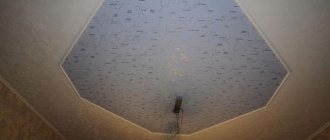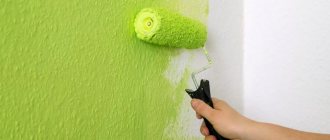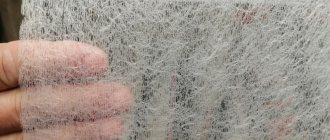Paintable wallpaper is the best option for those who want to make their interior unique. Their essence is quite simple: a clean canvas sets the relief, and paint sets the color. This solution is beneficial for those who are tired of seeing colorful drawings on the walls, wasting time on joining them, or simply want to use the canvas as a canvas for drawing. The article tells you which canvases can be painted and what you will need for this.
What kind of canvases can be painted?
Tip
Not all materials can be painted. Those of them that are already covered with a pattern are usually very fragile, and the coloring pigment will lie unevenly on them, and may soon peel off.
Coatings with special impregnation were invented. They make the canvas stronger, and by partially absorbing the coloring pigment, they securely fix the strip to the surface.
The base can consist of any material, but three types of wallpaper are most often used:
- Paper. A thick layer of cellulose fiber impregnated with a primer. The material is durable and will hide some unevenness in the walls. The rolls are quite cheap and easy to handle.
- Non-woven. Non-woven material is a non-woven material made from small compressed, usually synthetic fibers. The surface of the canvas is additionally treated with foamed vinyl, which gives the material a given texture.
- Glass wallpaper. This is a composite material - an interweaving of glass and paper threads. quite expensive canvas, has many advantages. Glass wallpaper hides wall defects well, is non-flammable, and can serve as an additional moisture and vapor barrier. They can often be found in public places due to their increased wear resistance.
Types of wallpaper for painting
1. Fiberglass. This type of material is very strong and durable. It is made from quartz threads, which contain sand, dolomite, lime and soda. The surface of such wallpaper imitates various textures. This feature allows them to visually align the walls, making the interior more comfortable.
2. Paper. During production, such wallpaper is impregnated with a water-repellent composition, which retains its properties even after several stains. Despite this, it is not recommended to wash the walls. This material also has a relief structure. Great for both walls and ceilings.
3. Non-woven. This material is obtained from dense fiber, which is pressed during production. The textured surface is created by applying foam vinyl through a stencil. This material is easy to glue; it allows you to hide small unevenness in the walls.
Is it possible to repaint if they are torn?
Answer: yes, but not always.
Most paintable wallpapers are multi-layered. In this case, with minor scratches, abrasions, or any other damage that does not affect the base layer adjacent to the wall, painting is permitted and should not cause difficulties. But if the wallpaper is old and torn because its integrity has been compromised, the tear may expose the wall, in which case care must be taken to repaint the surface.
Important
The solvent contained in the coloring composition can damage the wallpaper glue, then the fabric at the break point will bubble and may peel off. It’s better to cover the gap with a small amount of putty and then paint on top.
What will you need?
To decorate a wall with wallpaper for painting, you need several things:
- Floor protection material. Gluing, like repairs, is a dirty task. If there is an expensive laminate or any other covering on the floor that you would not want to damage with wallpaper glue or dust, you should buy plastic film (how to choose wallpaper for laminate?). It is easy to spread, and after repairs, roll it up and put it away along with construction waste.
- Masking tape is useful for protecting baseboards. It can be used to mark areas for painting.
- Primer. Sometimes the primer with which the canvas is impregnated may not be enough. Then the paint will reach the wallpaper glue and dissolve it. All your efforts will go down the drain. It is better to pre-treat the pasted wall.
- Paint that matches the type of wallpaper. For glass wallpaper, alkyd is usually used. They leave a thin protective film on the surface that will protect the coating from mechanical damage. After drying, it can be washed (how to clean wallpaper from dirt?).
- For non-woven and paper - water-emulsion, latex. It will not allow the fabric to get wet and will create a reliable barrier against fungi and mold, as it will not allow moisture to pass through.
- Brushes, rollers. A set of thin brushes can be very useful for painting corners and areas near baseboards. Rollers are suitable for large surfaces. If the wallpaper materials are smooth, then it is better to choose a roller with short pile. If embossed - with a long one.
How to preserve the texture of a material?
The natural texture of the wallpaper must be preserved. It will give the walls an original look and help hide defects in the wall surface, and sometimes even paint flaws.
How to maintain fine texture? Latex water-dispersive compositions fit well on the surface without painting the relief. The paint must be applied in at least two layers. The first layer is more liquid, the second is thicker paint. It is important not to be lazy when working with a roller so that the paint covers the wallpaper with a thin, continuous layer.
How to carry out the procedure correctly?
One of the advantages of paintable wallpaper is that it can be repainted from time to time. At least that's what most consumers think. But many who tried to do this were very disappointed with the result. In what cases is this idea good, and when is it better to just re-glue new ones?
Evaluate how well the coatings adhere to the wall. If they have already started to show noticeable bubbles and have sagged in some places, then an additional layer of wet paint will make the canvas heavier and make it completely peel off (how to remove bubbles on wallpaper and what to do if the coating peels off?).
If they hold up well, you can start painting. There are several rules.
- First, according to the relief: the finer it is, the greater the chances of painting it over.
- The second is the cleanliness of the paintings. The less dust on them, the better the paint will adhere. To clean the wall, you can use a vacuum cleaner or simply walk over it with a damp cloth. The surface must be completely dry.
- If the color is not too saturated or the previous color is still striking, you should wait until the painted canvases are completely dry, and only then try to paint them again, with a second layer.
How to paint wallpaper for painting
Before you start covering the wallpaper with paint, you need to prepare all the necessary materials and tools:
- Wool or velor roller. You need to keep in mind that these materials will not leave air bubbles or streaks on the wall. The usual foam rubber can ruin the design.
- Tassels. They should only be used in hard-to-reach places.
- Spray. It provides the most uniform and smooth wall covering.
- Paint tray. You need to pour a small amount of the composition into it and distribute it evenly over the roller.
If you need to replace dark colors with light ones
High-quality paintable coatings can be repainted many times. What if the next layer should be lighter than the previous one?
Many people who have tried to apply a coat of light paint over existing dark paint have complained that it takes more than five coats to completely change the color. It takes a lot of money, paint and effort.
If you don’t want to re-glue, but you need to change the tone from dark to light, you need to put another one on top of the main layer. Absolutely white. It will act as a primer and help you quickly change color. One or two layers of a new color are enough to completely change the color of the wall.
Coloring non-woven materials in a different color
The requirements for repainting non-woven materials are practically no different. It is worth making sure that the wallpaper fits tightly to the wall and will not peel off due to a slight increase in weight.
Advice
When repainting a lighter color, it is better to apply a layer of white color. If you paint it darker, this is usually not required.
We invite you to watch a video on how to paint non-woven wallpaper:
The pros and cons of non-woven wallpaper and instructions for gluing them can be found here.
How many times is it acceptable to do this?
Each painting case is individual, and the quality may depend on the condition of the coatings, walls, room humidity, etc. Factors influencing the number of re-paintings:
- Relief. The more prominent the relief pattern is on the wallpaper, the more difficult it is to paint over it over time. A weak relief pattern may be painted over after the third or fourth time.
- Paint viscosity. The more viscous it is, the thicker the film it will create on the surface. If you overdo it, then, firstly, the wallpaper will become very heavy and may peel off, and secondly, the textured pattern will become more and more blurry and fuzzy with each painting.
- Brush or roller bristles. The shorter it is, the denser the paint will be, the smoother the painted wall will be. If you try to paint a wall with a short-nap roller several times, the design on it will soon disappear. Buying embossed materials for painting will no longer make sense.
Attention
If you use wallpaper with a clear textured pattern, buy fairly liquid paint and a long-haired roller (or better yet, a spray gun). The number of repeated stains can be increased up to ten to fifteen times.
Design options
Before painting a room, you should think about the overall color scheme and design. Depending on the idea and the overall tone of the interior, you can paint a wall in different ways.
- Single color paint. The most common, simple and fast option, suitable for discreet and austere interiors.
- Painting in several tones. Here you can already show your imagination. You can paint each wall a separate color; sometimes it is necessary to highlight a niche with color, create a frame under the head of a bed or a false fireplace, etc. Colors can be alternated on one wall, creating stripes, diamonds, or applying paint in several layers using stencils.
- Uneven paint application. This method is especially appreciated in grunge or loft style interiors. The paint is applied with sharp strokes, sometimes diluted with a solvent to create an uneven texture and smudges.
- Craquelure effect. Created with a special varnish. Applied on top of the main background, it causes the paint to crack openly. Adds a slight antique effect, emphasizing the sophistication of the room.
- Gradient. If you paint the wall with two different shades, and then, even before the paint dries, start mixing it carefully (at the junction of colors) with a dry roller, you can get a very smooth, beautiful transition.
What is the dyeing technology?
- Dilute the water-dispersion composition with water to 15%. The thinner the dye, the easier it is to apply.
- First, brush along the entire perimeter of the wall: in the corners, near the floor and ceiling.
- Then use a roller to paint the wall inside the frame.
Important! Do not forget to ensure that the roller is well moistened with paint.
- There is no need to rub the wall. Roll the paint with quick movements.
Important! Missed areas should be painted over immediately, without waiting for the paint to dry.


